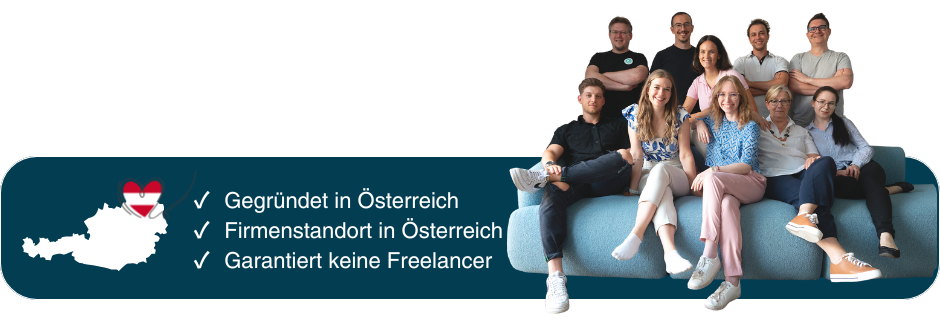SEO for online stores - guide & tips
Your store on page 1 through SEO
Google and other search engines bring people to your website - and to your online store. So if you want it to generate revenue, you need to design it so that people can find it on search engines like Google. And this is possible with SEO for online stores.
Here we have listed everything you need to know about SEO for online stores and give you further tips for your online store.
Note: To get the most out of our blog post, it is helpful if you are already familiar with the following terms. If not, simply click on the relevant links to find out more in our glossary. We wish you much success and enjoyment with your training!
Step 1: Choosing the store system
Before you even think about SEO for online stores, it is important to find the right e-commerce or store system.
This must not only fit your company, your requirements and your e-commerce strategy, but also be suitable for SEO (search engine optimization). This means, for example, that individual meta settings (title and description) must be possible in the system and the JavaScript should be SEO-compliant.
According to studies, the two most popular systems are WooCommerce and Shopify.
Then a store system is suitable for SEO
Here are a few more indicators that you can use to determine whether a system is suitable for SEO or not.
It is suitable if:
- Links are freely selectable (also anchor texts)
- Individual meta settings are possible (title & description)
- URLs are freely selectable
- You can determine canonical URLs
- A system that generates a lot of traffic
- elements are SEO-compliant (Javascript & pagination)
- A configurable sitemap is generated
- Individual headings are possible
- You can name images individually (including the alt tag)
- 301 redirects are possible
A lot of self-determination and individuality are therefore the two things that an online store system should always offer you - in terms of SEO - but also in general.
Further SEO functions for your online store
Apart from the points just mentioned, there are also some SEO aspects that are useful for optimal SEO for online stores:
- Structured data: z. e.g. FAQ page, reviews, articles, categories
- Reviews directly in the store: This creates user-generated content
- Related Products: an automated form of linking that shows customers similar products
- Search function: This should show products, but also make category searches possible
What you should avoid when choosing a store
Systems that only offer you limited options should be reconsidered three times rather than just once. Because if the system is not suitable for SEO or scalable, it probably won't make you happy in the long run.
We therefore advise against making hasty decisions. And even with providers who advertise low prices, you should check whether they really remain that cheap in the long term:
- If your store grows, will you incur extra costs for the expansion?
- Do you have to buy certain functions that are important to you?
- You also want to integrate a blog - is that even possible with the cheapest provider?
So think about what your goals are for your online store right from the start - even in the long term. Then you can make an informed decision.
Step 2: Keywords for stores
SEO and keywords go together like tar and feathers. If you want to optimize your online store for search engines, you can't avoid keywords here either.
Intensive keyword research is step number 1 here.
- are you addressing the right (willing to buy) target group
- you meet the search intention of your target group
- and can thus persuade them to make a purchase
In your SEO strategy, first focus on the so-called commercial keywords, i.e. those where people are looking for a product and want to make a purchase. These keywords are suitable for the product and category pages of your online store.
However, this keyword research is also important for another reason: it determines your entire further course of action. If the worm is in here, your entire foundation will wobble.
To give you a better idea of exactly what we mean by this, here are a few elements that are determined by your research:
- URL structure
- Structure of your store
- Navigation structure
- SEO texts
- Product descriptions
Find keywords through competitor analysis
You can find suitable keywords for your online store using a wide variety of Tools find. You can also take a look, what is searched for on Google and use that as initial inspiration.
In addition, however, a Competitor analysis valuable insights. Here you can often find out not only which keywords a competitor is ranking for, but also how many backlinks they have and how quickly new ones are being added. This is exciting, as backlinks also play a major role in search engine optimization (more on this later).
Depending on the tool, you can not only see which keywords your competitors are ranking for, but also which of their pages are attracting the most website visitors. Our Tip: Use a page like this as inspiration for your online store!
Step 3: The store structure
Now we come to the structure of your online store. Well thought out, it improves both its User Experience as well as the SEO potential. You should therefore only consider this website or store structure after the keyword research.
After that, it is also about finding meaningful internal links within your online store. This is because Google uses internal links to recognize which pages of your online store are important and which are less so. You should also keep the "depth" of your links in mind: Nobody likes to click 10 times until they reach the desired page. Therefore:
Do not use more than three levels. Here is an example:
- Level 1: Category page (for example: women's shoes)
- Level 2: Subcategory page (for example: ankle boots)
- Level 3: Product page (specific product)
Your start page is considered to be level 0 of your website, from which these three sub-levels then descend.

Important: Always keep it clear. Your online store or your entire site should be easy and intuitive for users to use. That way, they can quickly find the products they want and stay on your website for longer. And that in turn makes Google happy too!
There are now even tools on the Internet that you can use to visualize your online store structure. This makes it easier for you to identify optimization potential.
Onpage optimization related to SEO for online stores
Onpage SEO is about Improvements directly on the website (in this case the online store) itself.
Your potential customers should receive all important information quickly, in detail and in a user-friendly way.
Keywords are a very important point here. Onpage optimization also includes, among other things:
- Google Snippets
- H1 Headings
- Text quantity
- Rich snippets/structured data
1. google snippets
The snippet includes the title tag and the meta description. These are the first things users see in the search results on Google when they have searched for a term.
The Google snippet should therefore:
- Arouse interest
- Not too long and not too short
- Encourage clicking
- Include your keyword
Many online stores use automated snippets, but you should create them yourself, at least for the most important pages.
2. h1-headline
The H1 headline is the most important headline on a page. It allows you to show Google and potential customers what your page is about, i.e. what the main topic of your online store or website is.
It is extremely important for SEO.
Here, too, you should use your main keyword or the name of the product on the product page.
3. amount of text
The amount of text in your content is also important for on-page optimization. If someone is looking for products in an online store, they don't want a 3,000-word explanation or irrelevant content, but the most important information about the product.
To find the right amount of text, you can always check out your competitors. Base the amount of text in your content on the first three Google search results.
You should also always answer all of the customers' product questions in your content - sometimes you can do it in two sentences, sometimes you need two paragraphs.
4. rich snippets/structured data
Structured data in your online store is information in a special format. This can be interpreted more easily by search engines such as Google. Rich snippets can then be created based on this data and appear in Google & Co.
One example of this is the star ratings that you sometimes see directly in Google search results.
These snippets often increase the click-through rate and also ensure that Google and other search engines understand the content of your page better.
Offpage optimization related to SEO for online stores
This area of SEO for online stores is primarily about Backlinks. These are links that lead from another website to your online store. Backlinks are therefore like a Species recommendation ("Hey, take a look at the linked store, it's really good!").
If you have (as many as possible) backlinks, this also influences how Google and other search engines perceive you. After all, you get lots of "recommendations". This means your store must be good.
Important: The backlinks must come from trustworthy sites. If backlinks come from questionable sites, the question of how trustworthy your content and your store are will arise at some point.
Technical SEO for online stores
In this third area of search engine optimization, there are also some sub-items that you should look at:
- Short URL
- Fast loading time
- Avoid 404 errors
- Sitemap
1. short URL
According to studies, users don't like to click on long URLs. You should therefore keep your web address or that of your categories and products as short as possible.
It is also important that users know what to expect when they click on a link.
It therefore makes sense to include the relevant keyword here too - for example: www.komma99.at/blog.
Short, meaningful URLs help users, Google, SEO and ... you!
2. fast loading time
Searched for a product or content, found it, clicked on it and ... nothing. If customers have to wait forever for the content of your online store to load, they will quickly leave.
This increases the bounce rate of your website and you lose customers. Fast loading times prevent this problem from occurring in the first place.
3. Avoid 404 errors
404 errors are those where you are told, more or less creatively, that the page you are looking for cannot be found.
So if you remove products and items from the range and your online store, you should set up a 301 redirect for the affected pages. This will take users back to a functioning page of your online store or website and they will not receive an error message.
4. sitemap
A sitemap shows search engines an overview of all the pages that belong to your store. This overview is structured hierarchically.
This allows Google & Co. to better understand the structure and content of your webshop - which in turn has a positive effect on the ranking of your website.
Combine store with blog
You need commercial keywords with purchase intent for your store. But it is also advisable to expand your online store with a blog. Why is that?
There are several reasons for this:
- Found more often: Blogs tend to use informative keywords where users know something but don't want to buy yet. If you cover such search queries in addition to the commercial ones and create informative content, you will be found in more searches.
- Guide to purchase: If users inform themselves about a topic, this can bring them closer to making a purchase. With good content, you can arouse interest and attract people to your online store.
- Build trust: If your content is helpful, your products are often rated more positively. You build trust and lower inhibitions regarding a purchase.
Your content should always offer your (potential) customers added value. This will arouse their interest, build trust and keep them on your site for longer.
You also accompany them with a blog in other parts of their customer journey: the store covers the part where users are already interested in buying, the blog involves them at the moment when they first want to find out more.
Content marketing can therefore also indirectly increase the success of your online store.
3 more tips for your online store
Search engine optimization (SEO) for online stores is therefore important. It helps you to optimize your online store even better and make it more successful. It also makes it easier for customers and search engines.
But beyond search engine optimization, there are also some tips for online stores that we would like to share with you.
1. incorporate confidence-building elements
Good content is not only important in marketing, but also for online stores. Products and articles that impress are just as important. But it also makes sense to strengthen trust in yourself and your store as a store.
How does that work? With confidence-building elements! These include Awards and seals, that show that you are a reputable store (for example: ProvenExpert, Trusted Shops, TÜV etc.).
Testimonials, reviews on Google and certificates are also good additional content that you should include in your online store.
2. pay attention to usability
Customers want to find what they are looking for. And they want to find it quickly. With a good User friendliness you support your customers - and help your store to be more successful.
A search function, clear navigation and easy-to-understand categories make it easier to find content (articles). Mobile optimization ensures that the whole thing is also possible from a smartphone.
3. make content shine
An online store does not only live from (in the best case search engine optimized) texts. Images are also indispensable here as another form of content. The only important thing is that they are professional pictures that optimally represent your articles.
E-commerce is very visual, so even a blurred, blurry or incorrectly formatted image can cast doubt on the quality of the product. However, if you approach your image content just as thoughtfully as your store structure and search engine optimization, you are on the safe side!






